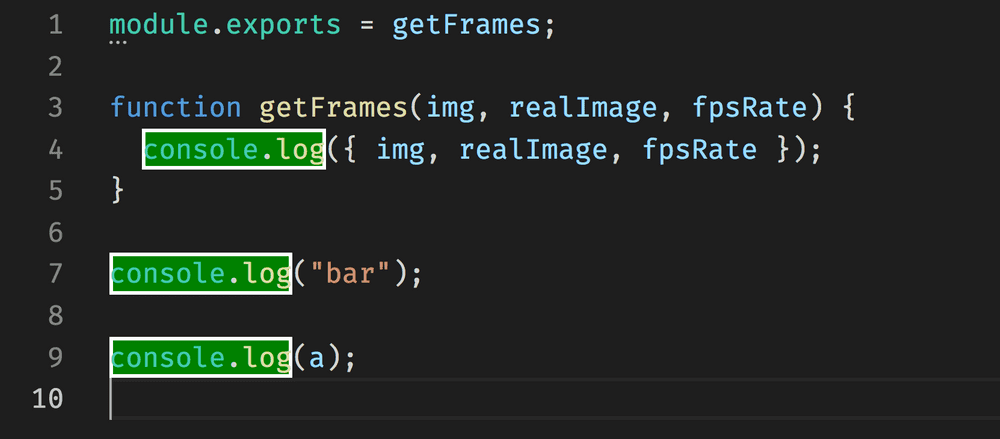What are decorations?
The Decorations API was introduced to Visual Studio Code as a way to decorate pieces of code. It allows you to grab ranges of text in an editor and decorate it using a subset of CSS properties. It does not modify the code but rather gives a visual addition in VS Code to how you can interpret your code.
As well, in VS Code 1.3, they added support to use the ::before and ::after pseudoelements on these decorations through the API which is commonly seen in various extensions now in 2018.
Extensions that use decorations
Decorations has been widely adopted across the extension community and here are a sample of extensions that show off what can be done with decorations:
: Highlights log4net logfiles to make them more readable
How to create decorations
To show off how to use the decorations, I am going to be writing an example extension that will highlight all locations of console.log in JS files
If you want to download the code to follow along, head over to lannonbr/console-log-highlighter. It was generated with the yeoman vscode generator.
If you open up src/extension.ts, The first piece of code is the decoration type.
const decorationType = vscode.window.createTextEditorDecorationType({
backgroundColor: 'green',
border: '2px solid white',
})This describes how we want to style the decoration. For this example, I am going to just decorate the text itself, but if you are interested, you can add before and after objects to add pseudo elements to the decoration. (GitLens uses this to push the inline blame after the end of the line)
The following things can be styled which map to their respective css properties:
- border
- outline
- color
- backgroundColor
- fontWeight
- textDecoration
- letterSpacing
- opacity
As well, you can insert these into light and dark objects so you can customize how it will appear for specifically light or dark color themes.
Next in the activate function, I have a event listener which will watch for document saves. Any time the file is saved this will be called. I grab the editor open and pass it into a decorate function which will do the heavy lifting on setting the decorations:
vscode.workspace.onWillSaveTextDocument(event => {
const openEditor = vscode.window.visibleTextEditors.filter(
editor => editor.document.uri === event.document.uri
)[0]
decorate(openEditor)
})Following is the decorate function which takes a vscode.TextEditor as a parameter. First we setup some boilerplate by grabbing the text from the editor, setting up a regex to look for console.log, and as well create an array where the decorations will live.
let sourceCode = editor.document.getText()
let regex = /(console\.log)/
let decorationsArray: vscode.DecorationOptions[] = []Next I loop over each line of the code and will try looking for console.log. If I can find it, I create a range for which the decoration will cover. Each decoration requires at least a range which includes a starting and ending position for where the text is. In VS Code internally, line and columns are 0-indexed, so if we had a file have console.log at the beginning of the document, it would start at line 0, col 0.
const sourceCodeArr = sourceCode.split('\n')
for (let line = 0; line < sourceCodeArr.length; line++) {
let match = sourceCodeArr[line].match(regex)
if (match !== null && match.index !== undefined) {
let range = new vscode.Range(
new vscode.Position(line, match.index),
new vscode.Position(line, match.index + match[1].length)
)
let decoration = { range }
decorationsArray.push(decoration)
}
}After creating the range, we create a object that contains that range and then we push it into the decorationsArray.
After looping through the code, we then pass the array of decorations we created as well as the decoration type to the editor to be created.
editor.setDecorations(decorationType, decorationsArray)Here is the entire source for the extension.ts file in whole:
import * as vscode from 'vscode'
const decorationType = vscode.window.createTextEditorDecorationType({
backgroundColor: 'green',
border: '2px solid white',
})
export function activate(context: vscode.ExtensionContext) {
vscode.workspace.onWillSaveTextDocument(event => {
const openEditor = vscode.window.visibleTextEditors.filter(
editor => editor.document.uri === event.document.uri
)[0]
decorate(openEditor)
})
}
function decorate(editor: vscode.TextEditor) {
let sourceCode = editor.document.getText()
let regex = /(console\.log)/
let decorationsArray: vscode.DecorationOptions[] = []
const sourceCodeArr = sourceCode.split('\n')
for (let line = 0; line < sourceCodeArr.length; line++) {
let match = sourceCodeArr[line].match(regex)
if (match !== null && match.index !== undefined) {
let range = new vscode.Range(
new vscode.Position(line, match.index),
new vscode.Position(line, match.index + match[1].length)
)
let decoration = { range }
decorationsArray.push(decoration)
}
}
editor.setDecorations(decorationType, decorationsArray)
}Now if you open the debugging menu and run the Extension launch configuration or press F5, a debugging instance of VS Code will open up. Open up a JS file that has a few console.log calls and press save and you should see the decorations in action:
Gotchas & Tips
Some things to know when using decorations. First, the decorationType object is very important when updating decorations. decoration type objects are used as the key for decorations so if you send a new array of ranges to be decorated, it will overwrite them. That said, if you call the createTextEditorDecorationType function every single time you want to insert decorations, it will treat each one as a new instance which can cause unexpected behavior down the road. to mitigate this, either store the type globally or as a member variable of a class.
As well, do try to be efficient with updating decorations, as it could get computationally costly if updating decorations often if you are decorating the entire file rather than a single line or scope of code.
That’s it for this week. In a future post, I am going to discuss a sister-api to this, CodeLens, which adds actionable decorations above code lines


